
Passiontide refers to the last two weeks of Lent; it begins on Passion Sunday and ends on the Easter Vigil. Passion Sunday is the Sunday right before Palm Sunday (Fifth Sunday of Lent). During Passiontide, the practice of covering crosses and other sacred images in the church may be observed. Crosses are covered until the end of the celebration of the Lord’s Passion on Good Friday. Other sacred images remain covered until the beginning of the Easter Vigil. The practice of covering crosses and sacred images is based on the Gospel reading on Passion Sunday, which comes from John 8:46-59. In that Gospel reading, Jesus “hid” Himself from the people:
Jesus said to them, “Amen, amen, I say to you, before Abraham came to be, I AM.” So they picked up stones to throw at him; but Jesus hid and went out of the temple area.” (John 8:58-59)
Some people suggest that the reason for veiling the sacred images during Passiontide is that the divinity of Christ was veiled from the people during His suffering. Therefore, the faithful also veil sacred images inside the church. In what way was Christ’s divinity hidden during His Passion? From His agony in the garden of Gethsemane, through His arrest, scourging, crowning with thorns, carrying His Cross to Calvary, being nailed to the Cross and dying on the Cross, I imagine that Jesus, in His humanity, was tempted each step of the way by Satan to give it all up: You don’t have to suffer, quit now, manifest Your divinity and show these people who You really are. Each step of the way, the suffering of Christ became more and more unbearable, but Jesus did not give up and persisted in doing His Father’s will; He completed His mission of redemption all the way to His Death on the Cross. This is a lesson for all of us: We are tempted many times each day; but do we give in too easily? We need only to look at the Cross and ask Jesus to help us overcome temptation.
What comes to your mind when you see a cross? For many Christians, a cross represents the Cross upon which Jesus Christ died in order to redeem mankind from sin and death. The cross is especially significant for Catholics. We make the sign of the cross in the name of the Father, and of the Son, and of the Holy Spirit. We do this to bless ourselves, and when we begin and end in prayer.
The cross is a sign of God’s great love for us. While it reminds us that Jesus died on the Cross for our sins, the cross is also an instrument of healing. The Book of Numbers chapter 21 calls our attention to the healing and life-giving powers of the cross. The serpent fashioned by Moses and lifted up on the pole became the source of healing for anyone who looked upon it. Snakes bit the rebellious people and many of them died, but it was a snake made of bronze which was lifted up on a pole that saved the rest of them. In the same way, Jesus Christ lifted up on the cross is a source of healing for anyone who contemplates it. The cross was an instrument used to inflict a painful and shameful death, but when Jesus Christ was lifted up on the Cross, His unique Sacrifice has become the source of salvation.
The Cross of Christ is a symbol of the great love of God who sent His only Son into the world to save it. This great love has inspired many to follow Christ and to love God and neighbor. The love that prompts us to give of ourselves is but a reflection of the magnanimous love of God on the cross. Let us make this week a truly holy week by making a conscious effort to live out the great mystery of God’s love in our daily lives.